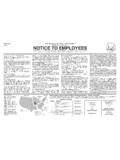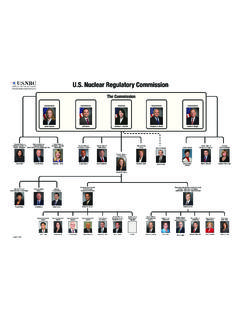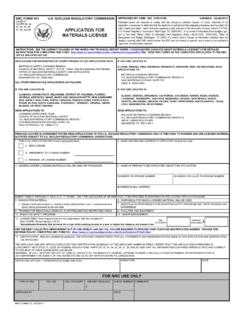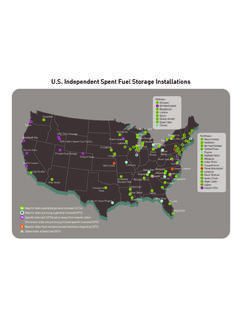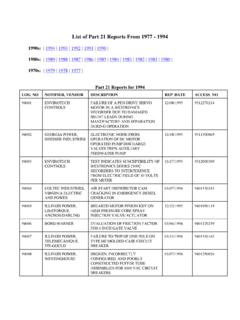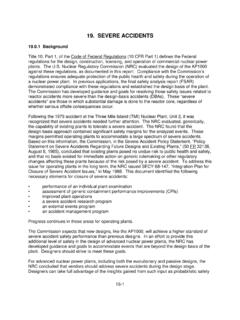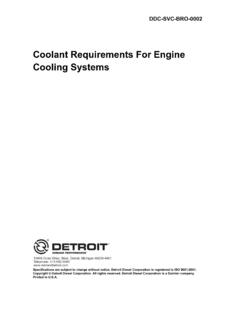Transcription of 6.0 ENGINE COOLING SYSTEMS If this heat is not removed ...
1 Emergency Diesel Generator ENGINE COOLING SYSTEMS ENGINE COOLING SYSTEMS If this heat is not removed , ENGINE internal temperatures would soon reach a point of This chapter identifies the major component damage and ENGINE failure. All components of the diesel ENGINE COOLING commercial diesel engines use some form SYSTEMS and explains how each system is of COOLING system to absorb this heat and necessary for reliable operation of the transfer it to a heat absorbing medium ENGINE . outside of the ENGINE . Learning Objectives Many modern engines are equipped with turbocharging SYSTEMS to provide enough As a result of this lesson, you will be able to: air to allow the burning of the fuel required to produce the required power. The 1. State the purpose of a diesel ENGINE turbocharging system adds heat to the jacket water COOLING system .
2 Combustion air. In order to ensure that sufficient pounds of air are provided for the 2. Identify the major components of a combustion of the fuel, it is necessary to typical diesel ENGINE jacket water cool the combustion air before it goes into COOLING system and describe the the ENGINE cylinders (to maintain the air operation of each. density). This is done by means of a radiator-like heat exchanger called the air 3. State the purpose and describe the intercooler, or aftercooler, and mounted in operation of the jacket water keepwarm the piping between the turbocharger and circulation system as is commonly compressor outlet and the ENGINE air used on nuclear application diesel manifold. This radiator removes excess engines. heat from the combustion air.
3 Water from either the jacket water system or from the 4. State the purpose of a diesel ENGINE service water system (the ultimate heat intercooler (aftercooler) water COOLING sink) may be used in this heat exchanger. system . When service water is used, there may be an additional heat exchanger between the 5. Identify the major components of a service water system and the intercooler typical diesel ENGINE intercooler water water system so that the water in the system and describe the operation of intercooler system can be treated and each. maintained in a state that will not contribute to the deterioration of the air intercooler. 6. Identify other COOLING requirements, such as ENGINE room COOLING . COOLING system Basics ENGINE COOLING Most diesel engines use a closed loop jacket type COOLING system .
4 coolant flows Approximately 25 to 30 percent of the total through the ENGINE absorbing heat from the heat input to the ENGINE supplied by the fuel cylinder liners, cylinder heads, and other is absorbed by the ENGINE COOLING system . ENGINE components. Rev 1/11 6-1 of 11 USNRC HRTD. Emergency Diesel Generator ENGINE COOLING SYSTEMS coolant Temperature - As a and free of deposits or scale forming general rule, the higher the temperature of substances. De-mineralized water is most the coolant leaving the ENGINE , the more frequently used. The water should be efficiently the ENGINE will operate. On the slightly alkaline, specifically meaning a pH. other hand, extremely high coolant of 8 to temperatures can allow overheating of ENGINE components which could cause Addition of a corrosion inhibitor such as structural damage.
5 Jacket water may also Nalco 2000 is recommended to prevent the be used to cool the lubricating oil through a build-up of scale on cylinder liners and heat exchanger. For most diesel engines, cylinder heads. One sixteenth inch of scale a jacket water discharge temperature of is like adding one inch of steel with respect about 180oF is preferred with a temperature to the resistance to heat transfer from the rise through the ENGINE in the range of 8 ENGINE . Periodic chemical analysis of the to15oF. coolant is performed and corrective amounts of corrosion inhibitor added to ENGINE coolant - Water is the maintain proper water chemistry. most common coolant used in diesel engines. However, water alone presents ENGINE COOLING SYSTEMS the possibility of corrosion, mineral deposits, and freezing.
6 A typical closed loop diesel ENGINE COOLING system is shown in Figure 6-1. Where engines could be subjected to temperatures near or below freezing, an In the following discussion, the word antifreeze such as ethylene glycol or 'radiator' could be substituted for 'heat propylene glycol must be added. The most exchanger' on engines equipped with a common solution is a 50/50 mix of radiator. On some units, there are antifreeze and water, which is good for separate radiator sections for COOLING the temperatures down to -40oF. Commercial intercooler water and the jacket water. In antifreeze includes corrosion inhibitor such cases, the lube oil is typically cooled additives. Adding antifreeze does from the jacket water circuit. negatively affect heat transfer.
7 coolant is stored in the ENGINE system itself Diesel engines used for emergency service with the assistance of an expansion tank at nuclear facilities are not generally (head or make-up tank) which is mounted subjected to temperatures where freezing at a point above the ENGINE to maintain a is a possibility. Under these conditions, head on the system . The ENGINE -driven use of antifreeze is not required. However, pump draws suction on the system and the corrosion inhibitor additives can be delivers the coolant to the ENGINE . In most mixed with demineralized water to provide SYSTEMS , the water exits the ENGINE and corrosion protection. goes through a thermostatically controlled valve. From the valve, the water either Water Chemistry - The water goes through the heat exchanger, if the used for ENGINE coolant should be clean water is hot, or through a bypass line Rev 1/11 6-2 of 11 USNRC HRTD.
8 Emergency Diesel Generator ENGINE COOLING SYSTEMS around the heat exchanger when the water from the incoming air charge. On many is too cold. engines with intercoolers or aftercoolers, a separate heat exchanger passes this The thermostatic control valve (TCV) excess heat to the service/raw water senses and reacts to coolant temperature. system . This is most desirable in as much When the temperature of the ENGINE as it is best to cool the intercooler water to coolant is below the set-point of the valve, a temperature below that of the jacket coolant is bypassed around the jacket water system . ALCO engines generally water heat exchanger. When the coolant use the jacket water system to cool the temperature is above the set-point, the intercooler water.
9 Valve directs the coolant through the heat exchanger where the excess heat is Expansion Tank - Many ENGINE transferred to the raw or service water use an expansion tank with a pressurized system . Service water flow is automatically closure, or the expansion tank is mounted initiated upon any type of diesel ENGINE high enough to maintain the necessary start. head (net positive pressure head - NPSH). on the system . The expansion tank is From the outlet of the heat exchanger, or usually located slightly above the highest bypass line, the water returns to the jacket point in the jacket COOLING water system and water pump and thereby to the ENGINE . In vent lines are used to continuously purge many SYSTEMS , the lube oil system is air from the system .
10 Some expansion cooled by a heat exchanger in the jacket tanks may be pressurized to maintain a water system . On engines where it is higher pressure which is helpful in raising desirable to keep the lube oil at a the boiling point of the COOLING fluid. temperature lower than that in the jacket water system , the oil heat is transferred Standpipe - A standpipe is a directly to the service/raw water system vertical tank mounted at the same elevation through the lube oil system heat exchanger as the ENGINE . It stores ENGINE coolant as shown in Chapter 5. while providing an air space to compensate for thermal expansion of the coolant . As the coolant enters the cylinder block, it Standpipes are generally vented to the is directed by internal passages and/or atmosphere providing a non-pressurized piping to the lower end of the cylinder COOLING system .

